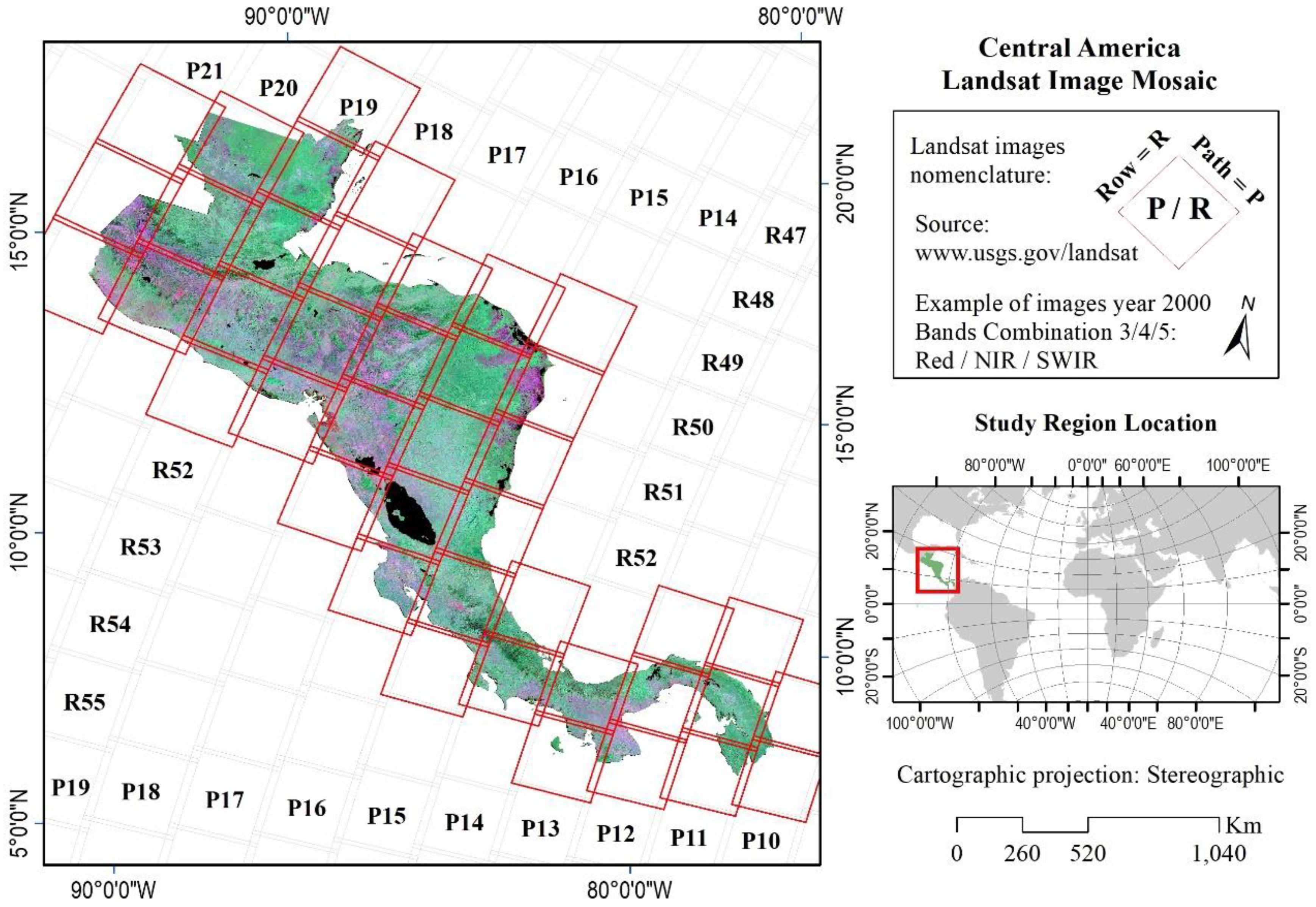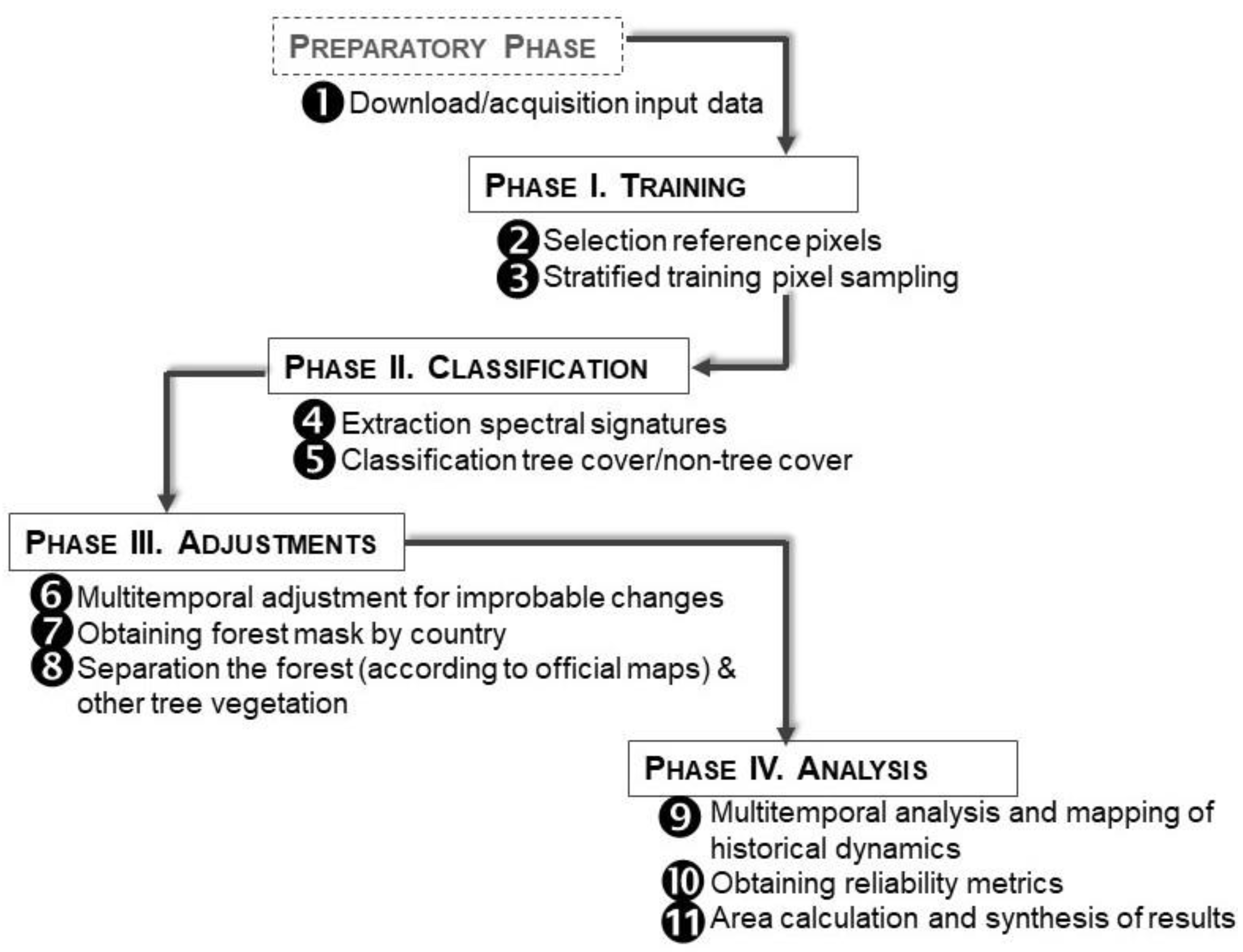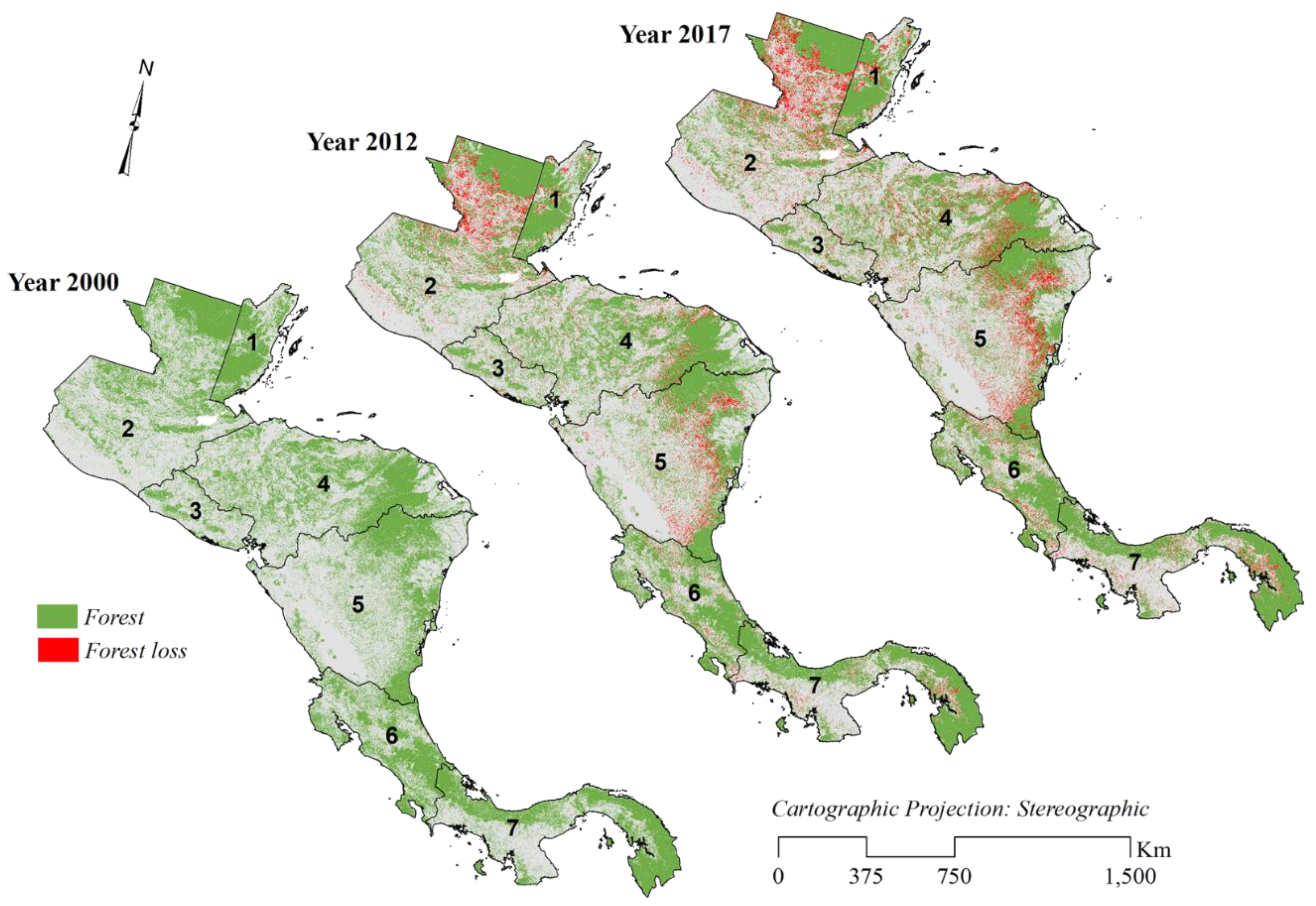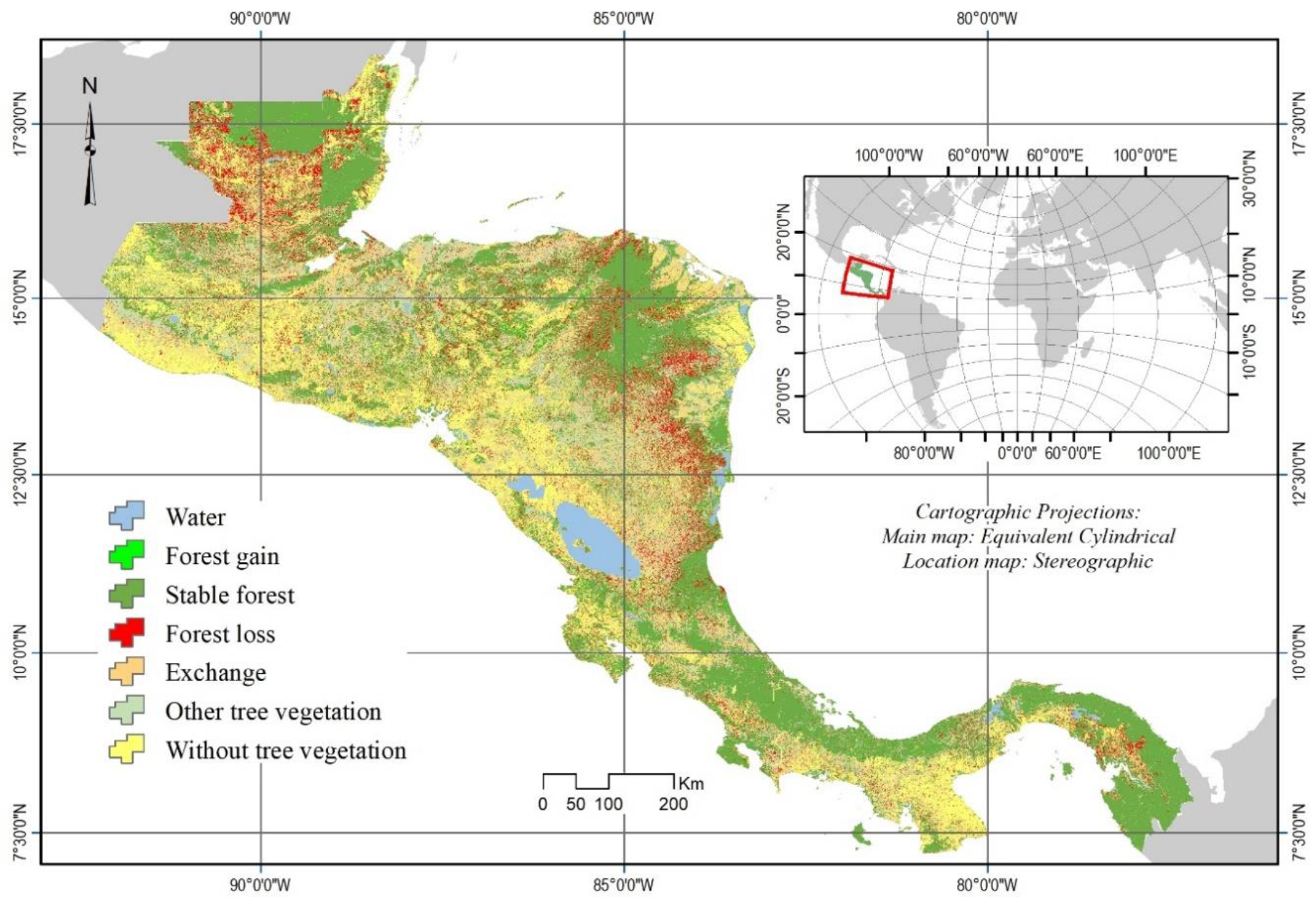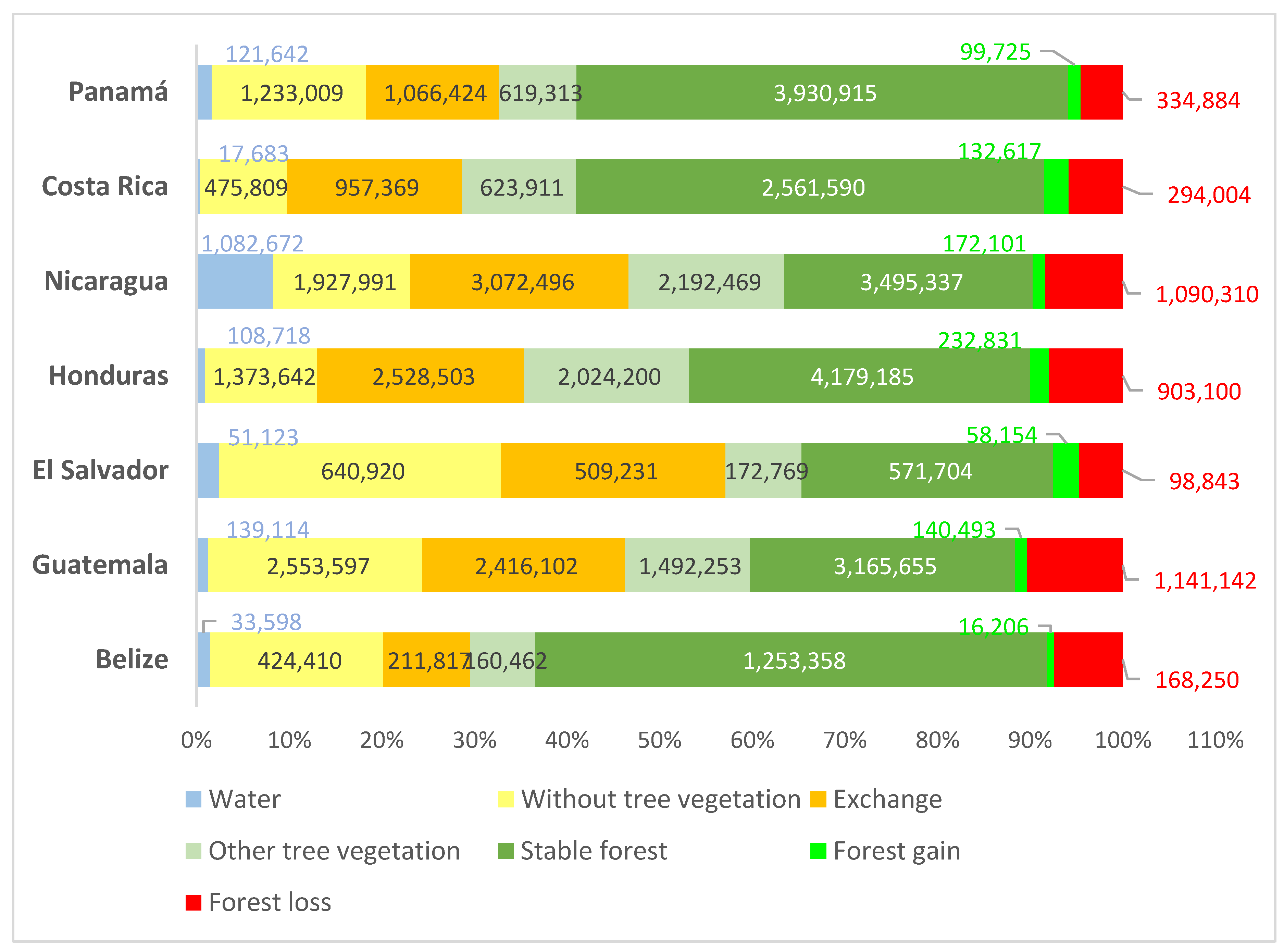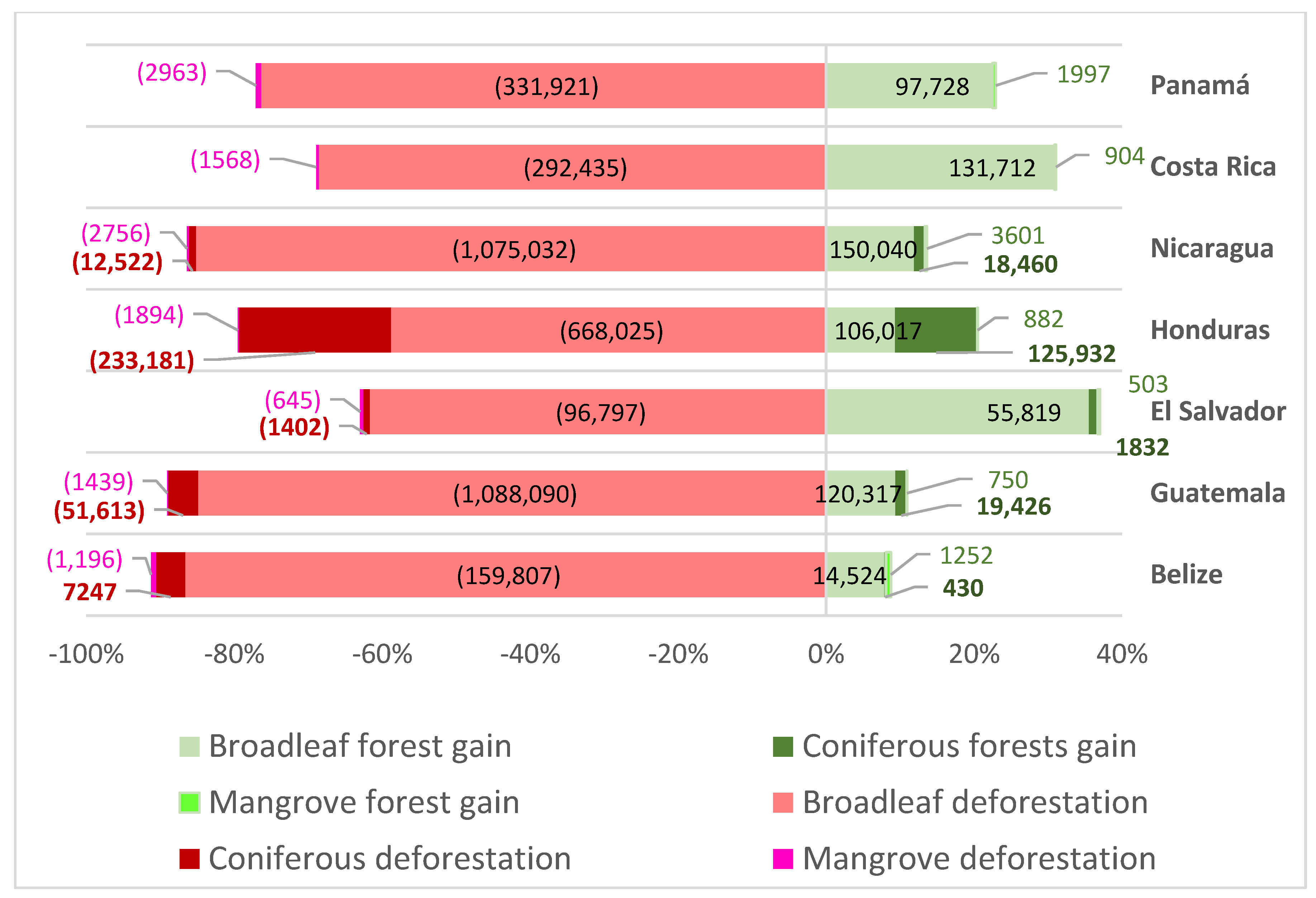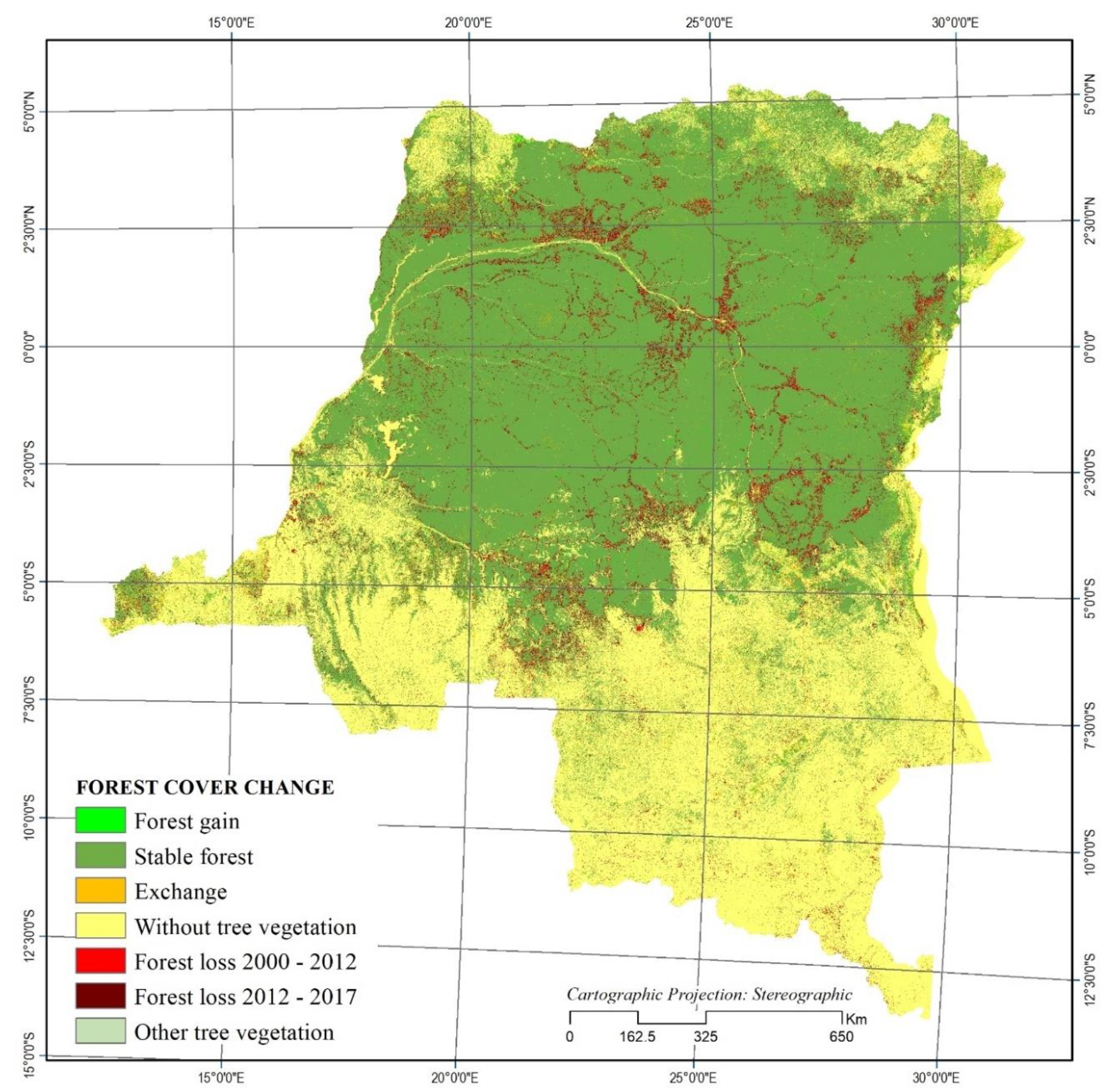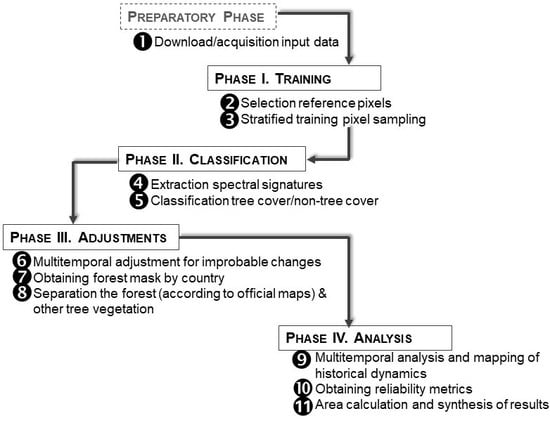1. Introduction
Satellite monitoring, as a tool to support decision making aimed at halting forest destruction, has been prioritized in the last decade under the mechanism known by its initials REDD+ (reducing emissions from deforestation and forest degradation). REDD+ is an initiative of the United Nations Framework Convention on Climate Change (UNFCCC) that requires the implementation of consistent, transparent, and robust national monitoring systems, maintaining a balance between the costs required for monitoring and the resources that are necessary to allocate for the execution of direct actions to reduce deforestation. One of the ways to reduce monitoring costs is to take advantage of the economy of scale to generate useful global or regional protocols and products at the national level. The objective of the research was to develop and apply a theoretical–methodological framework (as a technical input in the decision-making process to curb deforestation) in order to cost-efficiently prepare national cartography on forest cover, which is temporarily consistent, scalable at the supranational level for the Central American region, and applicable to other tropical regions.
1.1. State of the Research Field
Since the end of the 20th century, different initiatives have taken place to generate forest maps in the Central American countries and/or the region as a whole. STEP (System for Terrestrial Ecosystem Parameterization), developed from the Global Observation for Forest Cover and Land Dynamics (GOFC/GOLD), was one of the first vegetation mapping experiences at a regional level in Central America with Advanced Very High Resolution Radiometer (AVHRR) images (from 1 km spatial resolution [
1].
In 2000, the Central American Commission for Environment and Development (CCAD) produced the Map of Ecosystems of Central America based on the visual interpretation of Landsat images and field verifications, reconnaissance flights, and the participation of experts in ecology from the region [
2]. In 2003, Giri and Jenkins [
3] generated a regional forest cover map for Central America and Mexico in which, using Moderate Resolution Imaging Spectroradiometer (MODIS) of 500 m resolution, nine types of vegetation cover were identified. The most recent regional cartography is the 2010 Central American Map of Land Use and Cover, prepared by the Center for Water in the Humid Tropics for Latin America and the Caribbean (CATHALAC, Panama City, Panama) from MODIS images of 500 m resolution, which applied a methodology of supervised classification for the identification of sixteen land cover classes [
4].
At the national level in Central America, most of the forest cover maps have been generated from Landsat images [
5,
6,
7,
8,
9]. However, in an effort to improve the scale of forest mapping and land cover, national forest type maps were developed with 5 m resolution RapidEye satellite imagery, acquired in 2012 in Honduras [
10], Costa Rica [
11], Guatemala [
12], Panamá [
13], El Salvador and Nicaragua [
14]. More recently, in 2019, Guatemala published a new map of forest cover for the year 2016 and dynamics 2010–2016 [
15]; in Panama that same year, a diagnosis on the coverage of forests and other wooded land was prepared, which was based on a 2019 update of the forest map [
16]. Other countries, such as Honduras [
17] and Nicaragua [
14], have also reported information on the dynamics of forest cover at REDD+ reference levels submitted by the countries to the United Nations Framework Convention on Climate Change (UNFCCC, New York, NY, USA).
Among the forest cover classification algorithms, the most widely used in Central America is the maximum-likelihood classifier (MLC). It was used to generate the series of forest cover maps with Landsat images from 2001, 2006, and 2010 in Guatemala [
6,
7]; in Belize, for the elaboration of the forest map series of 1980, 1989, 1994, 2000, 2004, 2010 and 2012 from Landsat images [
8,
18], and to generate the map of forest types with RapidEye images from 2014 in Honduras [
10] and from 2015 in Guatemala [
12]. At the regional level, MLC was applied to prepare the 2010 Central American Map of Land Use and Cover [
4].
Currently, taking advantage of improvements in data processing, it is now possible to access from the cloud a large number of orthorectified and geometrically corrected images under the global land survey standard [
19], and derived from new policies of open access to satellite data by this means, it is possible to access the complete historical catalog of Landsat images [
20]. The development of new radiometric standardization methods is also currently allowing the generation of global, regional, national, and subnational image mosaics [
21], ensuring uniform access to spatially and temporally standardized satellite images [
22].
The progressive consolidation of the cloud as a paradigm for the delivery of information and services is facilitating the management and massive analysis of large volumes of satellite data, making traditional analysis scene by scene less feasible and leading some authors to talk about “the end of per scene analysis” [
23]. In this context, the University of Maryland, together with Google and the United States Geological Survey (USGS, Reston, VA, USA), taking advantage of the benefits of cloud computing, implemented a project to generate worldwide mapping of the loss and gains of tree cover, with a resolution of 30 m using Landsat images [
24].
The objective of this article is to develop a theoretical–methodological framework for the cost-efficient elaboration of national cartography on forest cover in Central America, temporarily consistent and scalable at the supranational level. Workflows are proposed to reduce the time usually taken by the satellite image classification process, automating the capture of training samples from multisource data and incorporating automated human decision adjustments post-classification based on expert criteria.
1.2. Contextual Framework
The Central American region is a relatively small portion of territory, where different vegetation types coexist, such as humid forest, dry forest, coniferous forest, mangrove swamps, and even some specifically localized niches of xerophytic scrub and flooded vegetation [
2]. It is for this reason that it has become a key region for conducting studies on the dynamics of tropical forests that can be extrapolated to other sites with similar characteristics.
However, most of the mapping of forest cover generated in Central America from remote sensor data have been prepared separately for each country applying different criteria [
6,
7,
8,
9,
10,
11,
12,
13,
14,
15,
16], making it difficult to obtain a complete and comparable vision for the entire region. Tropical countries share similarities in vegetation types [
2], and this facilitates the generation and use of data in a shared way, such as training samples, mosaics of satellite images, and classification protocols. In this context, as part of this research, the requirement to develop and apply a methodology that allows the generation of national maps of forest cover using a regional framework was addressed.
There are several challenges in digital image classification processes for the mapping of forest cover; some are related to errors in pixel assignment in the mapping carried out in Central America and are corrected by making a visual sweep across the map and recoding the pixels to assign them to the right classes [
6,
7]. The problem derived from this practice is that it is difficult to replicate, since most of the time the decisions and criteria used by the interpreter when making the corrections are not recorded, and if they are documented, it is not ensured that each one of the pixels is visited by visual sweep with these types of inconsistencies corrected. In this study, it is proposed to develop a method that allows the introduction of human decisions based on expert judgment to include them within the same classification model, so that they are applied automatically.
Another challenge is related to the fact that not all the pixels classified as tree cover in a classification process are necessarily forest according to the national definitions adopted. A pixel in one country may correspond to forest, but the same type of vegetation detected in that pixel in another country could be considered non-forest. For example, in some countries early secondary vegetation is considered secondary forest, but in other countries that same type of vegetation is classified as secondary non-forest vegetation. In this sense, this research considers the application of national forest masks to separate what proportion of the pixels classified as tree cover correspond to forest according to national definitions.
In summary, the problem addressed in this study focuses on addressing the challenges facing tropical countries and, specifically, those of Central America to generate data on forest cover dynamics under the same theoretical–methodological framework replicable in a context supranational regional (regions made up of several countries). At the same time, it seeks to reduce the effort, cost, and time involved in preparing national forest mapping in small countries, such as Central America, by developing a method that can be replicated in countries and/or large areas, also with limited financial and human resources. The replication potential and scalability of the methodology was explored to be applied to other tropical regions of greater territorial extension.
3. Results
3.1. Reliability of Forest Cover Mapping
The overall accuracy of the cartography generated for Central America in the forest/non-forest categories was 76% for 2000 and 79% for 2012. At the national level, the best accuracies were registered in Belize, Panama, and Costa Rica; the lowest were obtained in Honduras, El Salvador, Guatemala, and Nicaragua (
Table 6 and
Table 7).
According to the reliability assessment using the Kappa index (κ) and applying the categories proposed by Landis and Koch [
28] to characterize the agreement between the classified pixels and the validation sample points, the results obtained in this study are located in the categories of moderate agreement (κ between 0.4–0.6) and considerable (κ between 0.6–0.8) (
Table 8).
3.2. Forest Cover
According to the results obtained, in 2000, Central America was covered by 43.8% of forest, a percentage that fell to 41.5% in 2012 and 38.3% in 2017 (
Figure 5). In general, all countries presented a lower percentage of forest in the year 2017 compared to 2000. However, in the period 2000–2012 in El Salvador and Costa Rica, gain trends were observed (
Table 9).
In terms of forest types of the total forest area of Central America, in 2017, 92.4% corresponded to broadleaf forest, 5.7% to coniferous forest, and 1.9% to mangrove forest. In the years 2000, 2012, and 2017, the area of broadleaf forest in Central America corresponded to 21,244,989 ha; 19,914,860 ha, and 18,489,948 ha; that of coniferous forest at 1,257,003 ha, 1,362,352 ha, and 1,137,548 ha, and that of mangrove forest at 380,228 ha, 393,873 ha, and 382,374 ha.
3.3. Forest Cover Change Dynamics
In addition to individually evaluating the forest area in each year, a forest cover change dynamics multitemporal analysis was performed. The change categories refer specifically to gains and losses that, from the forest monitoring perspective, correspond to deforestation and forest regeneration. Persistence refers to the absence of such changes, areas that in this study are within the categories of stable forest; other tree vegetation; exchange; without tree vegetation, and water.
Figure 6 shows the Central America forest cover change dynamics map for the period 2000–2017, and the percentage distribution of stable forest with respect to the rest of the categories of forest cover change dynamics in relation to the total area of each country is shown in
Figure 7.
The highest proportions of stable forest were found in Belize, Panama, and Costa Rica, and the lowest in Nicaragua, Guatemala, and El Salvador. Regarding the exchange (associated with migratory agriculture processes), the greatest extensions (ha) were found in Nicaragua, Honduras, and Guatemala, countries that at the same time presented the greatest areas of forest loss. Regarding the areas without tree vegetation (associated with agricultural crop areas, urban areas, and other areas without tree vegetation), the highest proportion was found in El Salvador. In the category of other tree vegetation (mainly early secondary vegetation), the highest percentages with respect to the other categories, and also in terms of area, were found in Nicaragua and Honduras. In proportional terms, it was in Costa Rica and El Salvador where the highest gains were located.
For Central America as a whole, the average deforestation in the first period was 197,443 ha/year (2000–2012), and that of the second period was 332,243 ha/year (2012–2017). The average for the entire period was 264,843 ha/year (2000–2017). The first monitoring event in 2018 showed deforestation of 167,976 ha for that year, which is below the averages of both periods but very close to that of the first period.
Table 10 shows a summary of the annual deforested area by country in the periods 2000–2012, 2012–2017, 2000–2017, and that of the year 2018.
By forest type, in the 2000–2012 period, the annual loss of broadleaved forest in Central America was 190,600 ha/year, and it went up to 284,982 ha/year in the 2012–2017 period. The coniferous forest presented an average annual loss of 6763 ha/year in the first period, and it went up to 44,961 ha/year in the second. The largest increase in annual average deforestation by forest type occurred in the coniferous forest of Honduras, which went from 3778 ha/year in the first period to 37,570 ha/year in the second. A percentage of 29.3 of the total deforestation in Central America of the broadleaf forest occurred in Guatemala, 29.0% in Nicaragua, and 18% in Honduras. As for the coniferous forest, 76.2% of the losses were in Honduras and 16.9% in Guatemala. Panama concentrated 23.8% of the region’s losses in the mangrove forest, Nicaragua 22.1%, Honduras 15.2%, Costa Rica 12.6%, Guatemala 11.5%, Belize 9.6%, and El Salvador 5.2%.
Total gains for the region in the 2000–2012 period were 1,158,185 ha of which 26% were deforested in the following period, which means that of these gains only 852,126 ha remained in 2017. For the period 2012–2017, as it is a relatively short time to assess forest regeneration, gains were not analyzed. For the 2000–2017 period, 79.3% of the total forest gains in the region occurred in broadleaf forest, 19.5% in conifers, and 1.2% in mangrove. 22.2% of the gains in the broadleaf forest were in Nicaragua, 19.5% in Costa Rica, 17.8% in Guatemala, 15.7% in Honduras, and 14.5% in Panama. In the coniferous forest 75.8% of the gains were in Honduras, 11.7% in Guatemala, and 11.1% in Nicaragua. In relation to the mangrove gains, 36.4% of the total of the region occurred in Nicaragua, 20.2% in Panama, and 12.7% in Belize (
Figure 8).
3.4. Application of the Methodology in Other Tropical Zones
The results of replicating the methodology in the Democratic Republic of the Congo (DRC) showed that forest area decreased from 59% in 2000 to 52.2% in 2017 (
Table 11).
The total forest loss in the country in the 2000–2017 period was 11,163,201 ha of which 6,113,521 ha were deforested in the 2000–2012 period and 5,049,679 ha in the 2012–2017 period (
Table 12).
Figure 9 shows the forest dynamics map of the Democratic Republic of the Congo (DRC), obtained as part of the replication of the methodology developed in this study.
In the State of Pará, Brazil, the results show that forest area decreased from 81.3% in 2000 to 75.3% in 2017 (
Table 13).
The total loss of State forest in the 2000–2017 period was 9,378,400 ha of which 5,701,899 ha were deforested in the 2000–2012 period and 3,676,501 ha in the 2012–2017 period (
Table 14).
Figure 10 shows the forest dynamics map of the State of Pará, Brazil, obtained as part of the replication of the methodology developed in this study.
4. Discussion
Most official forest cover maps prepared to date in Central America were generated independently by each country [
6,
7,
8,
9,
10,
11,
12,
13,
14,
15,
16], making it difficult to integrate to obtain an overview of the situation and evolution of forests in the regional context. In response to this, in this research a methodological framework was developed to generate cost-efficient national maps of forest cover in Central America as a whole. The similarities of tropical countries in terms of vegetation types facilitated the generation of these maps by using satellite data, multisource secondary data, and training samples on a shared basis. The applied regional approach offers advantages in terms of reducing costs and time, as well as improving the consistency and coherence of reports at different territorial levels (regional and national), reducing duplication of efforts, and optimizing these forms of technical and financial resources.
The results indicate that in Central America, all the countries presented a lower percentage of forest in 2017 compared to 2000. This general trend of decrease at the regional level is consistent with that observed for the period 2000–2010 in the regional study by CATHALAC [
4].
The trends of decrease in forest cover observed in this research would also be in line with the official data reported to FRA-2015 by most of the countries in the region [
29], with the exception of Costa Rica, where the data indicated a trend towards a constant increase in forest cover since 1990 that had continued until 2015 [
30], and in El Salvador, which according to data reported in FRA-2015, had a constant trend towards a forest cover decrease in the period 1990–2015 [
31]. However, in this study, in the period 2000–2012, increases in forest cover of 1.6% and 0.2%, respectively, were observed in both countries, and a trend of decrease in the following period, 2012–2017, in both.
At this point, it should be taken into account that, for example, in El Salvador in the report to the FRA-2015, since there were no historical data about forest cover loss, an annual rate of deforestation was estimated using expert’s criteria, applying it to the 2002 map, and projecting the previous and subsequent years [
31]. In contrast, the global land cover data generated by European Space Agency (ESA) [
32] for El Salvador shows a trend of recovery of the country’s forest cover from 1992 to 2000, and from this year, it seeks to stabilize. However, it should be taken into account that, compared to the 30 m resolution and 30% canopy threshold used in this study, the ESA data were generated at 300 m resolution and considering a canopy greater than 15% to classify a pixel as forest, resulting in a larger area of forest detected. Many pixels included in this research within the category other tree vegetation (non-forest) would be considered forest in the data provided by ESA.
In Costa Rica, the forest gain trend from 1990 that continued in 2015, which was reported to FRA-2015, does not coincide with what was observed in this research, which showed a forest cover decrease in the period 2012–2017. In this country in the FRA-2015 report, forest cover for 2010 was estimated by applying a linear extrapolation based on data from 2000 and 2005; to obtain the cover forest area of the year 2015, the area of the 2013 map was projected, using the trend 2005–2010 [
30]. The losses that could occur in the period 2012–2017 in Costa Rica observed in this study were not included in the projection to 2015 of the report to the FRA, which assumed the continuity of a gain trend, which could contribute to the differences between both sources.
In Honduras, the loss of forest cover reported at the REDD+ reference level for the 2000–2016 period was 22,696 ha/year [
17], much less than the 67,223 ha/year obtained for the 2000–2017 period in this study, and even lower than the average forest loss rate obtained for the 2000–2012 period of 32,981 ha/year and 101,465 ha/year for the 2012–2017 period. These differences could be due to the fact that, by national definition, forest losses within areas included in the category of Sustainable Forest Management and forest cover losses caused by the pine beetle pest that affected the country in 2015–2017, were excluded in the official quantification of deforestation, but both cases were considered in this investigation. Official figures from August 2016 indicated that this pest had already affected 495,967 hectares of the country’s coniferous forest [
17].
The last official report on forest cover in Guatemala indicated that the country had maintained 33% of its forest by 2016 [
15], a value higher than that observed in this study of 30% by 2017, but similar to the case of 2012 where 33.9% was officially reported, and 33.1% was obtained in this investigation.
The percentage of Panama forest cover officially presented in 2019 was higher than those obtained in this study; compared to percentages of 72.8%, 66.1%, and 65.4% of coverage of ‘forests and other forest land’, respectively, for 2000, 2012, and 2019 [
16], in this research values of 57.1%, 56.3%, and 54.4% were obtained for the years 2000, 2012, and 2017, respectively. The differences could be influenced by the category stubble and shrubs vegetation that was included within forest cover in the 2019 study, which was considered an initial vegetation state in transition to forest.
In Nicaragua, the REDD+ reference level values indicate that for the years 2000, 2010, and 2015 the percentages of forest cover in the country were 41.8%, 31.06%, and 30.21%, respectively [
14]. The data obtained in this study was lower, 34.38% for the year 2000, 31.2% for 2012, and 28.1% for 2017, but in both sources, a trend towards the decrease in the forest cover is marked, which places Nicaragua, along with Guatemala and Honduras, as countries with the largest deforested areas in the period analyzed in Central America.
In Belize, the information generated by Cherrington et al. [
8,
18], based on Landsat images, for the year 2000 reported a forest cover of 65.8% and 61.6% for 2012; in this study, for those same years, 62.5% and 56.0% were obtained. Part of these differences could be related to the fact that the model developed and applied in this research has not been able to adequately detect the coniferous forest areas in the center of the country. The reason for the limitation in the detection of this type of forest could be due to the fact that the coniferous forests of Central America present a high variability in the density of the tree canopy, presenting large extensions of sparse forests that are spectrally confused with dry scrubs.
Scrubs and dry forests also mix spectrally with crop areas, mainly because this type of vegetation loses its canopy at the period of least rainfall of the year. These detection limitations could at the same time be the reason that the lowest accuracies in the forest mapping generated in this study occurred in Honduras, the country with the highest proportion of coniferous forest in the region, and in El Salvador, which has the highest proportion of dry forest in the region with respect to the total area of national forest cover.
In general, for Central America the percentage of forest cover obtained in this study with respect to the data in the FRA-2015 [
29] report is less than 1% in 2000 and 2017 and higher by 1% in 2012. In the Democratic Republic of the Congo, with respect to the official data presented to the UNFCCC [
33], the percentage of forest cover of the year 2000 obtained in this study is higher by 2% but similar in 2012 when compared to the 2014 data reported to the UNFCCC (0.1% difference). In the case of the State of Pará, Brazil, when compared to the data generated by the MapBiomas Project [
34], the percentage of forest cover obtained in this study is less by 1.3% in 2012 and is also less for 2000 and 2017 with a difference of 3.3% and 3.9%, respectively.
Potential improvements in this study are expected in the future, incorporating independent validation processes of the secondary data sources used (such as the national forest masks and secondary data of tree cover loss), as well as the use of higher resolution satellite images, such as Sentinel and digital terrain elevation models. These potential improvements are based on the findings of recent studies where it has been found that the combination of multisource data, which were not used in this study, could provide significant improvements in the detection of forest types, as in the case of Sentinel-2A (S2), Sentinel-1A (S1) in dual polarization, and Shuttle Radar Topographic Mission Digital Elevation (DEM) combined with multitemporal Landsat images [
35]. Other improvements would be related to the inclusion of secondary data sources to exclude from forest losses the areas that, being subject to forest management, cause temporary reductions in the tree canopy and other forest losses that are legally authorized.
5. Conclusions
With this research, a theoretical–methodological framework has been developed and applied to cost-efficiently prepare national cartography on forest cover, temporarily consistent, and scalable at the supranational level in the Central American region and in other tropical regions of the world. Forest maps were generated considering the Central American region as a whole, with the expectation that later the regional classification will be adopted to the country level for multitemporal forest cover changes study. With the proposed methodological development, progress has been made with respect to the previous studies carried out in Central America, going from classifying individual scenes of Landsat satellite images and separately by country to doing so in a regional context. Additionally, new geoprocessing elements have been incorporated into the digital classification procedures for satellite images, such as the automated extraction of training samples from secondary sources, the use of official national reference maps that respond to nationally adopted forest definitions, and automation of post-classification adjustments incorporating expert criteria. The time involved in the classification process using automated workflows through the implemented algorithms was significantly reduced in relation to the traditional classification methods used in the countries of the region.
In terms of forest loss area by country, the largest deforested areas in the period 2000–2017 were in Guatemala, Nicaragua, and Honduras, countries where the greatest areas of gain were also located. However, when calculating the percentage of gain with respect to the total area of each country, the highest proportions were observed in El Salvador and Costa Rica. In terms of the percentage of forest with respect to the total national territory, Belize is the country that maintains the highest forest cover in the region, followed by Panama and Costa Rica; the lowest percentage of national forest was observed in Honduras, Nicaragua, Guatemala, and El Salvador. In terms of accuracy of the classifications obtained for the forest/non-forest maps, the lowest was obtained in Honduras, Guatemala, El Salvador, and Nicaragua, corresponding on the scale of the Kappa index to the category of moderate concordance. The best accuracies were obtained in Belize, Panama, and Costa Rica, ranking according to the Kappa index in the category of considerable agreement.
The application of the classification model generated in this study to other tropical areas of great territorial extension, such as the Democratic Republic of the Congo (DRC) and the State of Pará in Brazil, allows us to conclude that with the applied method, in addition to reducing the time involved in the analysis of forest cover dynamics in territories of large areas such as those selected, it is also possible to improve the scale of the existing mappings. As was the case in the DRC, where the best map obtained as input was 300 m of resolution in 2012, applying the model resulted in a 30 m map. Although, due to limitations of the research resources a validation of the results was not carried out, when comparing the results obtained with the official data of the country presented to the UNFCCC in terms of percentage of coverage at the national level, in 2012 a difference of 0.1% was found compared to the results of this study.
